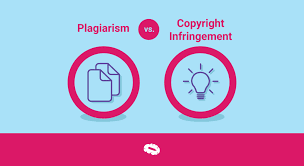In today’s digital world where content is shared rapidly across blogs, social media, academic platforms, and business websites, plagiarism and copyright infringement have become increasingly common—and problematic. Though the two terms are often confused or used interchangeably, they are quite different in nature, consequences, and legal implications. Whether you’re a student, writer, content creator, or business owner, understanding plagiarism and copyright is essential for maintaining credibility and legal safety.
What is Plagiarism?
Plagiarism is the act of copying someone else’s work, ideas, or words and presenting them as your own without giving proper credit. It is considered an ethical violation, particularly in academic and creative settings.
Common Types of Plagiarism
- Direct Plagiarism: Copying text word-for-word without attribution.
- Self-Plagiarism: Reusing your own previously published work without disclosure.
- Mosaic Plagiarism: Borrowing phrases from different sources and blending them without citation.
- Accidental Plagiarism: Failing to cite sources correctly due to lack of knowledge.
What is Copyright?
Copyright is a legal right granted to the creator of original works—including literature, music, art, and software—giving them exclusive rights to use, distribute, and monetize their content. Unlike plagiarism, which is about ethics, copyright is about legal ownership.
What Can Be Copyrighted?
- Books, articles, and poems
- Movies, music, and videos
- Software and websites
- Paintings, photographs, and sculptures
- Blog posts and social media content
Difference Between Plagiarism and Copyright Infringement
| Aspect | Plagiarism | Copyright Infringement |
|---|---|---|
| Nature | Ethical issue | Legal violation |
| Focus | Not giving credit | Unauthorized use of copyrighted work |
| Consequences | Academic penalties, reputational damage | Legal actions, fines, lawsuits |
| Ownership | Doesn’t involve legal rights | Involves rights held by the copyright owner |
You can plagiarize something that is not copyrighted (like public domain content), and you can infringe copyright even if you give credit (because you didn’t have permission to use it).
Legal Frameworks and Acts
India
Under the Copyright Act, 1957, any unauthorized use of copyrighted work is punishable. The act provides protection for literary, musical, artistic, and cinematic works.
USA
The Copyright Act of 1976 governs usage rights and infringement laws. The Digital Millennium Copyright Act (DMCA) provides further protection, especially for digital content.
International
Organizations like WIPO (World Intellectual Property Organization) help enforce copyright laws across countries through treaties such as the Berne Convention.
Consequences of Copyright Infringement
- Legal Penalties: Heavy fines, lawsuits, or even imprisonment in severe cases.
- Content Removal: DMCA takedown notices can lead to content being deleted from websites and platforms.
- Loss of Reputation: Authors, bloggers, or brands caught infringing may lose their audience’s trust.
- Monetary Loss: Companies may lose advertising or affiliate income if content is removed or blacklisted.
How to Avoid Plagiarism and Copyright Issues
For Writers and Students
- Always cite sources properly using MLA, APA, or Chicago styles.
- Use plagiarism checkers like Grammarly, Turnitin, or Copyscape.
- Paraphrase ideas in your own words and provide attribution.
For Businesses and Content Creators
- Use royalty-free images or licensed assets from sites like Unsplash or Shutterstock.
- Acquire licenses for music, videos, and software.
- Include proper credits and disclaimers when using third-party content.
Fair Use and Public Domain
Fair Use
Fair use allows limited use of copyrighted material without permission, typically for:
- Education
- Commentary
- News reporting
- Research
However, this is a gray area, and misuse can still result in legal consequences.
Public Domain
Works in the public domain are not protected by copyright and can be freely used by anyone. Examples include:
- Classic literature like Shakespeare’s works
- Government publications
- Expired copyrights (usually after 50–70 years)
Why It Matters
In an age of digital transformation, originality has become a critical asset. Whether you’re a student submitting a thesis, a brand creating ads, or a YouTuber producing videos, respecting intellectual property promotes:
- Creativity and innovation
- Trust and authenticity
- Legal compliance
Final Thoughts
Both plagiarism and copyright infringement can cause serious harm—not just legally but also to your integrity and career. The best defense is knowledge, transparency, and a proactive approach to content creation. Always strive to create original work, and when in doubt, cite, ask for permission, or leave it out.


 Watch
Watch
 CASUAL WEAR
CASUAL WEAR



[…] world, where content is created, shared, and consumed at lightning speed, understanding how to avoid plagiarism and copyright violations is critical for anyone working with words, media, or intellectual […]
[…] creativity, commentary, education, and research to thrive. But what exactly is fair use? How much copyrighted content can you use legally? And when does it cross the line into […]